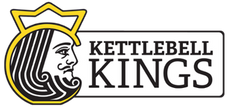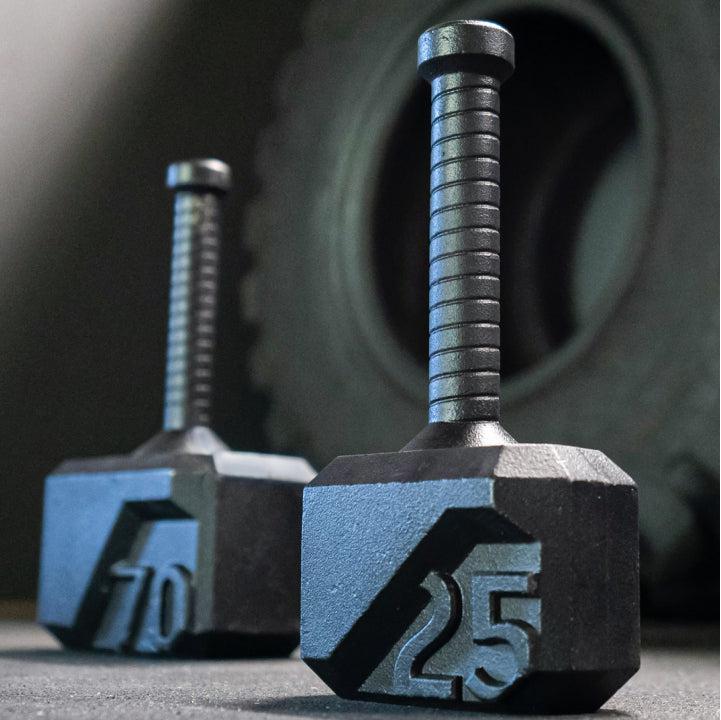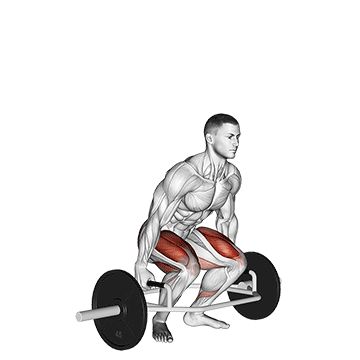Are you ready to unleash the primal power lying dormant within? To tap into that untamed strength and ferocity that's been caged for far too long? Well, fitness warriors, the time has come to liberate your inner beast through the mind-blowing hex bar deadlift.
This badass variation of the classic deadlift will have you channelling your primitive ancestors who conquered the world through sheer brute force. Forget those wimpy straight bars - the hexagonal design allows you to keep a neutral grip and upright torso, utterly obliterating your back, legs, and core in one explosive movement.
But be warned - the hex bar deadlift is not for the faint of heart. You'll need to summon every ounce of courage, grit and intensity as you slowly master this savage lift. The rewards, however, are worth the sacrifice: muscle that'll rip through your clothes, superhuman strength, and the predatory confidence to take on any challenge life throws your way.
The hex bar deadlift, also known as the trap bar deadlift, is a powerful strength-building exercise that offers unique advantages over the traditional barbell deadlift. In this comprehensive guide, we will delve deep into the intricacies of hex bar deadlifts, covering everything from technique and benefits to variations and programming.
What is the difference between a Traditional Barbell Deadlift and Hex Bar Deadlift?
Before delving into Hex Bar deadlifts in detail ,one must know that how it is different from Traditional Barbell Deadlifts. Here's a comparison between the hex bar deadlift and barbell deadlift
|
Aspect |
Hex Bar Deadlift |
Barbell Deadlift |
|
Bar Design |
Hexagonal-shaped bar with neutral grip handles |
Straight barbell with overhand or mixed grip |
|
Grip Position |
Neutral grip (palms facing each other) or pronated grip |
Overhand or mixed grip (overhand and underhand) |
|
Starting Position |
Inside the bar, allowing a more upright torso position |
In front of the bar, requiring a forward-leaning position |
|
Lower Back Stress |
Reduced stress due to more upright posture |
Potentially higher stress due to forward lean |
|
Leg and Hip Engagement |
Emphasises quadriceps and glutes due to upright posture |
Places more emphasis on posterior chain (hamstrings, glutes, lower back) |
|
Mechanical Advantage |
Improved leverage for lifting heavier weights |
More challenging due to longer range of motion |
|
Muscle Activation |
Greater emphasis on quads, glutes, and traps |
More emphasis on posterior chain muscles (hamstrings, glutes, lower back) |
|
Risk of Injury |
Lower risk of lower back injury |
Higher risk of lower back injury due to forward lean |
|
Ease of Learning |
Generally easier to learn due to natural movement pattern |
Requires more technical proficiency and mobility |
|
Variations Available |
Deficit deadlift, paused deadlift, single-leg variations |
Sumo deadlift, Romanian deadlift, deficit deadlift |
|
Suitable for Beginners? |
Beginner-friendly due to reduced technical demand |
Requires more technique and mobility awareness |
|
Athletic Performance |
Improves vertical jump and acceleration |
Enhances overall strength and power |
This comparison highlights the differences between the hex bar deadlift and barbell deadlift, allowing lifters to choose the variation that best suits their goals, fitness level, and individual biomechanics.
Benefits of Hex Bar Deadlifts

The hex bar deadlift provides several key benefits that make it a valuable addition to any strength training regimen:
Reduced Lower Back Strain
The hex bar deadlift is renowned for its ability to minimize stress on the lower back, a common concern with traditional barbell deadlifts. This reduction in strain is attributed to the unique design of the hexagonal-shaped bar, which allows lifters to maintain a more upright torso position throughout the movement. Unlike the conventional deadlift, where the lifter must bend forward significantly to grasp the barbell, the hex bar deadlift encourages a more natural and ergonomic lifting posture. This upright torso position not only reduces the lever arm acting on the lower back but also helps distribute the load more evenly across the entire posterior chain, including the glutes, hamstrings, and erector spinae muscles.
Increased Quadriceps Engagement
The positioning of the lifter's center of gravity within the hex bar leads to greater activation of the quadriceps compared to the standard barbell deadlift. As the lifter stands inside the hexagonal frame and lifts the weight, the knees are forced to extend against resistance, placing a substantial workload on the quadriceps muscles. This enhanced quadriceps engagement is particularly beneficial for individuals looking to develop stronger and more defined thigh muscles while still reaping the benefits of a compound movement targeting multiple muscle groups simultaneously.
Improved Mechanical Advantage
One of the primary advantages of the hex bar deadlift is the improved mechanical advantage it offers over the barbell deadlift. By standing within the confines of the hex bar, lifters can maintain a more neutral spine alignment throughout the lifting motion. This optimal alignment not only reduces the risk of spinal flexion or extension but also enhances force production by allowing the lifter to exert maximal effort against the resistance without compromising form. The improved biomechanics translate into more efficient and effective lifting, making the hex bar deadlift an attractive option for individuals seeking to build strength and muscle while minimising the risk of injury.
Enhanced Grip Options
Another standout feature of the hex bar deadlift is its ergonomic grip design. The neutral grip handles of the hex bar provide lifters with a more comfortable and secure gripping position compared to the traditional straight barbell. This ergonomic advantage reduces strain on the wrists and forearms during the lift, allowing lifters to focus solely on generating force through the lower body muscles. The neutral grip also promotes better alignment of the wrists, elbows, and shoulders, further minimising the risk of overuse injuries commonly associated with gripping heavy loads.
In summary, the hex bar deadlift offers a host of advantages over the barbell deadlift, including reduced lower back strain, increased quadriceps engagement, improved mechanical advantage, and enhanced grip options. These benefits make the hex bar deadlift an excellent choice for lifters of all levels seeking a safer and more effective alternative to traditional deadlifting, while still achieving remarkable gains in strength, muscle mass, and overall athletic performance
How to do Proper Hex Bar Deadlifts?
Here is the proper form and technique, lets delve into it:
Setup
- Position the hex bar on the ground so that you can stand inside it with your feet hip-width apart.
- Ensure the handles are aligned with your mid-foot position.
Grip
- Grasp the handles with a neutral grip (palms facing each other) or a pronated grip (palms facing down), whichever feels most comfortable and secure for you.
Lift
- Keep your chest up, shoulders back, and core engaged.
- Push through your heels and drive your hips forward to lift the bar off the ground.
- Maintain a neutral spine throughout the movement.
Lowering
- Lower the bar back to the ground with controlled movement, maintaining tension in your posterior chain muscles.
- Avoid dropping the weight abruptly to prevent injury.
Common Mistakes to Avoid
To maximise the effectiveness of the hex bar deadlift and minimise the risk of injury, avoid these common mistakes:
Rounded Back
Maintaining a flat or slightly arched back is crucial during the hex bar deadlift to protect your spine and optimise muscle engagement. A rounded back increases the risk of spinal disc compression and lower back strain. To avoid this mistake:
- Focus on bracing your core and keeping your chest lifted throughout the lift.
- Engage your lats (muscles of the upper back) to stabilise your spine.
- Initiate the movement by pushing your hips back while maintaining a neutral spine alignment.
- If you struggle to maintain proper form, reduce the weight and work on flexibility and core strength through targeted exercises like planks and bird-dog variations.
Excessive Forward Lean
Maintaining an upright torso is essential for maximising leg and hip engagement while minimising stress on the lower back. Excessive forward lean can shift the load onto the back instead of the intended muscle groups. To correct this mistake:
- Focus on pushing through your heels and driving your hips forward as you lift the bar.
- Keep your shoulders back and chest up throughout the movement.
- Maintain a vertical shin angle by avoiding excessive knee travel forward beyond your toes.
- Imagine pushing the ground away from you rather than pulling the bar upward with your upper body.
Over-reliance on Arms
The hex bar deadlift should primarily engage your legs and hips, not your arms. Overusing your arms can lead to inefficient movement patterns and increased strain on your upper body joints. To address this:
- Concentrate on pushing your feet into the ground and forcefully extending your hips forward to lift the bar.
- Maintain a firm grip on the handles but allow your arms to act as hooks rather than actively lifting the weight.
- Visualize the lift as a lower body movement, with your arms providing stability and control.
- Ensure that your lower body generates the power needed to lift the weight, not your arms.
Lifting Too Heavy Too Soon
Starting with a manageable weight allows you to focus on perfecting your technique and building strength progressively. Lifting too heavy before mastering the movement can increase the risk of injury and hinder your progress. To avoid this:
- Begin with a weight that allows you to perform the exercise with proper form for the desired number of repetitions.
- Gradually increase the weight as you become more proficient and confident in your ability to execute the lift safely.
- Listen to your body and prioritise the quality of movement over the quantity of weight lifted.
- Incorporate lighter warm-up sets and gradually progress to heavier working sets to acclimate your body to heavier loads.
By addressing these common mistakes and focusing on refining your technique, you'll optimise the effectiveness of your hex bar deadlifts and minimise the risk of injury, setting the stage for steady progress and improved strength gains over time. Remember, consistency and attention to detail are key to mastering this powerful compound exercise.
Which Muscles are Targeted by Hex Bar Deadlifts?

The hex bar deadlift is a compound exercise that primarily targets the following muscle groups:
- Quadriceps, The quadriceps muscles, located at the front of the thigh, are responsible for extending the knee during the lifting phase of the deadlift. As you push through your heels to lift the barbell, the quadriceps contract to straighten the knee joint, driving the upward movement.
- Hamstrings, located at the back of the thigh, play a crucial role in hip extension and knee flexion during the deadlift.The hamstrings work to extend the hips as you stand up with the weight, contributing to the powerful upward movement of the deadlift.
- Glutes, The gluteal muscles (gluteus maximus, medius, and minimus) are heavily involved in hip extension, which is a key component of the deadlift. The glutes contract forcefully to drive the hips forward and bring the body to an upright position from the hinge at the hips.
- Erector Spinae (Lower Back),The erector spinae muscles run along the spine and are responsible for stabilising the spine and maintaining proper posture during the deadlift. These muscles work isometrically to keep the spine in a neutral position throughout the movement, preventing excessive flexion or extension.
- Forearms and Grip, Holding onto the hex bar throughout the deadlift requires a strong grip and engages the muscles of the forearm. The muscles of the forearm (such as the flexors and extensors) contract to maintain a secure grip on the bar, especially during heavier lifts.
Training Tips and Variations
Let's further expand on training tips and variations for the hex bar deadlift, including programming guidelines and additional exercise variations to enhance your strength training routine:
Programming Frequency
- Incorporate hex bar deadlifts into your strength training routine 1-2 times per week, depending on your training goals and overall volume.
- Avoid performing hex bar deadlifts on consecutive days to allow for adequate recovery and muscle repair.
Set and Repetition Ranges
For Strength Development, Perform 3-5 sets of 4-8 repetitions with heavy weights that challenge your strength.
For Hypertrophy (Muscle Growth), Opt for 2-3 sets of 8-12 repetitions with moderate weights, focusing on controlled movements and muscle contraction.
Progressive Overload
-
Continuously strive to increase the weight or repetitions over time to promote strength gains and muscle growth.
-
Monitor your progress by keeping track of your lifts and adjusting the intensity accordingly.
Warm-Up and Cool Down
- Prioritise a thorough warm-up routine that includes dynamic stretches and activation exercises to prepare your muscles and joints for the hex bar deadlift.
- Incorporate mobility work and static stretching during the cool-down phase to aid in muscle recovery and flexibility.
Variations of Hex Bar Deadlifts
Deficit Hex Bar Deadlift
- Elevate yourself by standing on a raised platform (such as weight plates or a low box) to increase the range of motion and emphasize leg drive.
- This variation enhances strength development and challenges the muscles with a deeper stretch at the bottom position.
Paused Hex Bar Deadlift
- Pause for 1-3 seconds at the top or bottom of the lift to improve strength, control, and overall lifting mechanics.
- Focus on maintaining tension throughout the pause before resuming the movement.
Single-Leg Hex Bar Deadlift
- Lift with one leg off the ground while holding onto the hex bar with both hands to improve balance, stability, and unilateral strength.
- This variation targets each leg independently, helping to address muscle imbalances and enhance overall coordination.
How to incorporate Hex Bar deadlifts into your workout routine?
Incorporating hex bar deadlifts into your strength training routine offers numerous benefits for muscle development, strength gains, and athletic performance. Here's a detailed guide on how to effectively include hex bar deadlifts in your workouts:
Training Frequency
Beginners should start with one session per week to focus on learning proper form and technique. As you become more experienced, aim for 1-2 sessions per week, ensuring adequate rest and recovery between workouts. This frequency allows you to reap the benefits of the exercise without risking overtraining.
Set and Repetition Ranges
Tailor your sets and repetitions based on your training goals:
Strength Development, Perform 3-5 sets of 4-8 repetitions with heavier weights to build maximal strength. Use challenging weights that allow you to complete the desired reps with proper form.
Muscle Hypertrophy, Opt for 2-3 sets of 8-12 repetitions with moderate weights to promote muscle growth and endurance. Focus on controlled movements and muscle contractions throughout each set.
Endurance and Conditioning, Use higher rep ranges (12-15+ repetitions) with lighter weights to improve muscular endurance. This approach helps build stamina and metabolic conditioning.
Warm-Up
Prioritise a comprehensive warm-up routine before starting your hex bar deadlift session:
- Perform dynamic stretches and mobility exercises to increase blood flow and prepare your muscles for the workout.
- Activate key muscle groups such as the glutes, hamstrings, and core with specific drills like hip bridges, leg swings, and planks.
Perform Hex Bar Deadlifts
Execute the hex bar deadlift with proper form and technique:
- Set up the hex bar on the ground and step inside, ensuring your feet are hip-width apart and centered.
- Engage your core, keep your chest up, and maintain a neutral spine throughout the movement.
- Grip the handles firmly with either a neutral (palms facing each other) or pronated grip (palms facing down).
- Drive through your heels, extend your hips and knees simultaneously to lift the barbell off the ground.
- Keep the bar close to your body as you stand up, fully extending your hips and knees at the top of the lift.
- Lower the bar back down under control, maintaining tension in your muscles throughout the descent.
Incorporate Training Variations
Add variety and challenge to your workouts with different hex bar deadlift variations:
- Deficit Hex Bar Deadlift: Stand on a raised platform to increase the range of motion and target muscles more intensely.
- Paused Hex Bar Deadlift: Pause briefly at the top or bottom of the lift to enhance strength, control, and muscle engagement.
- Single-Leg Hex Bar Deadlift: Lift with one leg off the ground to improve balance, stability, and unilateral strength.
Monitor Progress and Adjust
Regularly assess your performance and progress with hex bar deadlifts:
- Track the weights used, sets, and reps to ensure progressive overload and continuous improvement.
- Adjust the volume and intensity of your workouts based on your performance and recovery.
Cool Down and Recover
Finish your hex bar deadlift session with a proper cool-down routine:
- Stretch the muscles used during the workout to promote flexibility, reduce muscle soreness, and prevent injury.
- Hydrate adequately and refuel with a balanced post-workout meal to support muscle recovery and growth.
By following these steps and incorporating hex bar deadlifts strategically into your training routine, you can maximise the benefits of this compound exercise. Remember to prioritise consistency, proper form, and gradual progression to optimise your training outcomes and minimise the risk of injury. With dedication and focus, hex bar deadlifts can play a key role in helping you achieve your strength and fitness goals effectively over time.
One-week workout plan for beginners
Here's a structured one-week workout plan for beginners incorporating hex bar deadlifts along with other fundamental exercises to build strength and improve overall fitness:
Week 1: Beginner Workout Plan
Day 1: Full Body Strength
Warm-Up:- 5-10 minutes of light cardio (e.g., brisk walking, jogging in place)
- Dynamic stretches (e.g., leg swings, arm circles)
- Hex Bar Deadlift: 3 sets of 8 reps
- Bodyweight Squats: 3 sets of 12 reps
- Push-Ups: 3 sets of 10 reps
- Dumbbell Rows: 3 sets of 10 reps (each arm)
- Plank: Hold for 30 seconds
- Static stretches targeting major muscle groups (e.g., quadriceps stretch, chest stretch)
- Deep breathing to relax and promote recovery
Day 2: Active Recovery or Rest
- Light activity such as walking, yoga, or stretching to promote recovery
Day 3: Lower Body Focus
Warm-Up:- Same as Day 1
- Hex Bar Deadlift: 3 sets of 8 reps
- Lunges: 3 sets of 10 reps (each leg)
- Calf Raises: 3 sets of 15 reps
- Leg Raises: 3 sets of 12 reps
- Plank: Hold for 30 seconds
- Same as Day 1
Day 4: Active Recovery or Rest
- Similar to Day 2
Day 5: Upper Body Focus
Warm-Up:- Same as Day 1
- Push-Ups: 3 sets of 10 reps
- Dumbbell Shoulder Press: 3 sets of 10 reps
- Dumbbell Rows: 3 sets of 10 reps (each arm)
- Bicep Curls: 3 sets of 12 reps
- Tricep Dips: 3 sets of 10 reps
- Same as Day 1
Day 6: Active Recovery or Rest
- Similar to Day 2
Day 7: Rest
- Complete rest day to allow for full recovery
Workout Tips for Beginners
- Start Light, Focus on mastering proper form and technique before increasing weights or intensity.
- Listen to Your Body, If you experience pain or discomfort during any exercise, stop and consult a fitness professional.
- Progress Gradually, Aim to improve each week by increasing weights or reps slightly once you feel confident with the movements.
- Stay Consistent, Consistency is key to seeing progress. Aim to complete the workouts as scheduled and gradually build your strength and endurance.
This beginner workout plan provides a balanced introduction to strength training while incorporating hex bar deadlifts to target major muscle groups. As you become more comfortable with the exercises, you can gradually increase the intensity and complexity of your workouts. Remember to prioritize proper form, rest, and recovery to optimize your fitness journey.
Answering Some Faqs
Here are some FAQs about hex bar deadlifts:
Q. What do hex bar deadlifts work?
A. Hex bar deadlifts primarily work the quadriceps, hamstrings, glutes, lower back (erector spinae muscles), and forearm muscles due to the need to grip the bar firmly throughout the movement.
Q. Is hex bar deadlift like a squat?
A. No, hex bar deadlifts involve lifting a weighted barbell from the ground with an upright torso position, focusing on hip and knee extension. Squats, on the other hand, involve bending the hips and knees to lower the body into a seated position and then standing back up, primarily targeting the quadriceps, hamstrings, and glutes.
Q. Is hex bar safer than deadlift?
A. Hex bar deadlifts are considered safer for some individuals because they allow for a more upright torso position compared to conventional deadlifts with a straight barbell, reducing stress on the lower back. The neutral grip handles of the hex bar also provide better ergonomics, reducing strain on the wrists and forearms.
Q. Can hex bar replace deadlift?
A. Hex bar deadlifts are not replacements for conventional deadlifts but can complement them within a strength training program. Both exercises target similar muscle groups but emphasize slightly different biomechanics. Incorporating both variations can provide a comprehensive approach to developing strength and muscle mass in the lower body and posterior chain muscles.
Conclusion
The hex bar deadlift stands as a versatile and impactful exercise for enhancing strength, power, and muscle development. By embracing proper technique and integrating hex bar deadlifts into your training regimen, you open doors to substantial progress in overall fitness and athletic performance. Remember to start slowly, focus on technique, and gradually increase the intensity as you become more proficient. With dedication and consistency, the hex bar deadlift can become a cornerstone of your strength training program, unlocking new levels of physical prowess and resilience.
In summary, the hex bar deadlift isn't merely an exercise—it's a gateway to a stronger, fitter you. Embrace its potential, commit to its mastery, and witness the transformation it can bring to your fitness journey. As you incorporate hex bar deadlifts into your routine, celebrate the milestones and relish in the journey towards a more robust and capable physique. Unlock your potential with the hex bar deadlift and embrace the benefits it offers on your path to strength and fitness excellence.










